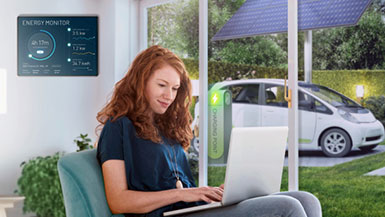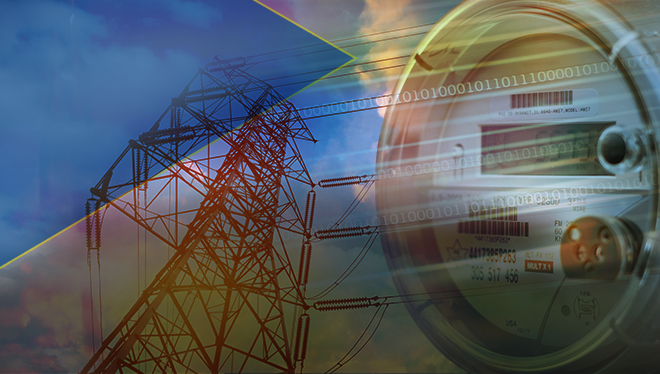
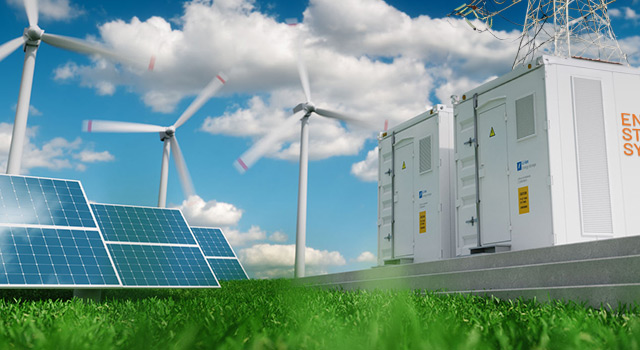
SIGNALS+ 在线快讯订阅
持续关注Signals+,了解有关连接、数字健康、电气化和智能工业的最新见解、信息和想法并加以利用。
NUVATION ENERGY的电池管理解决方案助力储能系统市场发展
储能系统(ESS)对于构建基于可再生能源的去中心化电网至关重要。电动汽车的电力需求日益增长,但可再生能源的供应并不稳定,时断时续。而ESS正是解决这些问题的关键。
ESS可以将多余的电能储存到电池中,并在用电高峰时释放出来,从而平衡电网的供需,维持电网稳定运行。为了确保ESS中的电池、控制系统以及连接基础设施等各个部分高效运行,就必须搭配安全、可靠且可扩展的电池管理系统(BMS)。我们需要通过创新来增强ESS的能力,提高运行可靠性,加强安全预防措施,并降低总拥有成本。
Nuvation Energy是固定式ESS市场的领军企业,其支持各种化学电池的可配置BMS能够灵活应对种种挑战。这种灵活性优势也使得ESS系统可以广泛利用各种电池资源,包括退役的电动汽车电池。为了推动下一代ESS创新,Nuvation选择与全球知名的ADI公司达成合作。ADI深耕行业多年,凭借深厚的技术积累、完善的现场支持服务以及精密的BMS电芯监测技术,能够帮助Nuvation高效应对技术难题,进而更好地满足市场需求,加快产品上市进程。
概览
公司简介
十多年来,Nuvation Energy一直致力于为ESS市场提供可配置的产品和工程服务,其电池和能源管理系统遍布世界各地,涵盖了公用电网、电动汽车充电站、太阳能储存以及电池包梯次利用等海量应用场景。
技术
基于LTC6811高精度电池监控器的电池和能源管理解决方案,包括专有电池连续均衡算法和高/低电压BMS模块。
挑战
尽可能地提升ESS的可用容量,并实现支持众多类型化学电池的BMS。尽可能地减少系统停机时间并提高电源转换效率。
目标
改善ESS的总拥有成本(TOC)。确保BMS性能可靠,并延长ESS寿命。帮助ESS制造商加速产品上市进程,让运营商不必自行开发和维护BMS。
共同的未来愿景

Nuvation Energy与ADI公司已经合作长达十年之久。2021年,Nuvation和ADI就未来愿景达成了共识,包括推动电动汽车电池的梯次利用,以及拓展电气化生态系统——这对Nuvation而言是一项重要的市场战略。从此,双方合作变得更加紧密。
Nuvation与ADI携手共进,为ESS设备开发了新一代产品Gen 5,实现了专为长期可靠性而设计的高/低电压BMS解决方案。在随后的两年里,Nuvation与ADI齐心协力,并肩作战,一同整合过往的技术成果,攻克重重技术难关。
克服挑战
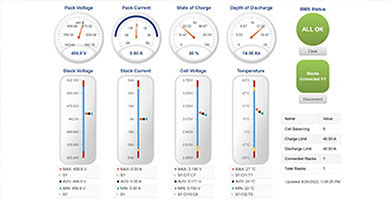
全面的电压和温度范围
经过审查和测试,Nuvation在其BMS中集成了ADI的LTC6811高精度电池监控器。这些技术相互配合,能够更精确地监控并管理高/低电压(60 V至1500 V)和能量密度更高的锂电池。Nuvation的电池均衡和充电状态(SOC)算法,有助于大幅提升电池的可用容量并减少系统停机时间。
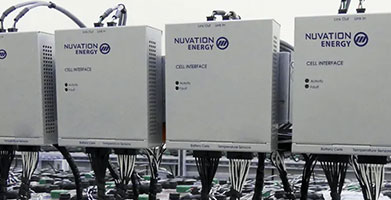
多种电池规格和化学体系
借助ADI的BMS电池监控传感器,Nuvation开发出了灵活的电池管理解决方案。该方案可以通过编程来支持众多类型电池的电压和温度范围以及充放电曲线。这些传感器还让ESS提供商能够从更广泛的供应商那里采购不同化学体系和容量的电池。
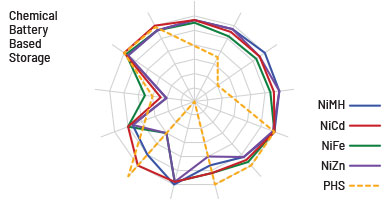
集成
Nuvation Energy的BMS使ESS设施能够轻松应对未来的扩容需求。随着技术的发展,以后的新型电池可能会采用全新管理模式和化学体系。Nuvation BMS的可配置能力将有助于简化这些电池的集成。

支持
Nuvation的BMS解决方案支持锂基电池(以及采用其他化学体系的电池)。锂基原电池比其他化学电池更昂贵,但在需要高能量密度和更快速充电的应用场景中,它是理想选择。系统为了提供冗余而增加的低使用率二次电池,可以延长系统的使用寿命。这些二次电池采用成本较低的化学体系,但充电速度可能较慢。
电池被动均衡与连续均衡
ESS在电池充电期间停机时,会给系统运营商带来经济损失。因此,为了提高ESS的效率,必须缩短停机时间,并避免电池在充放电过程中受到损害。下面将介绍两种电池电荷均衡方法,并比较二者的效率。
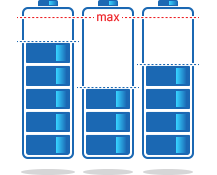
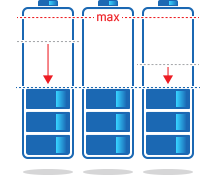
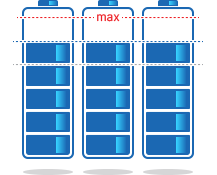
电池被动均衡利用充电周期顶端采集的电压变化数据进行工作。根据电池的不均衡程度,这可能会导致ESS的运行时间缩短,因为电池均衡需要将所有电芯充满电。BMS可以监控电芯的电压和温度,并向负责相互转换交流电和直流电的电源转换系统(PCS)提供关键数据,以帮助确保其在充放电过程中不会损坏电池,并在需要时启动预防性安全措施。

 连续均衡可在此区域的任何地方发生
连续均衡可在此区域的任何地方发生
 传统均衡可在此区域发生
传统均衡可在此区域发生
电池连续均衡采用Nuvation的G5 BMS和ADI的精密测量技术。当充电速度最快的电芯达到100%电量时,系统会定期评估电芯不均衡情况。Nuvation的BMS会在系统运行期间均衡剩余的电池,进而促使ESS迅速恢复全面运行。Nuvation Energy表示,在许多实际应用场景中,其创新型电池连续均衡方法可使ESS正常运行时间达到99%以上。1
电池梯次利用市场
国际能源署在其“新政策情景”中预测,到2030年,全球上路行驶的电动汽车数量将超过1.25亿辆2。电动汽车使用8至10年后,其电池包仍能保持原始充电容量的70%至80%,并且仍可继续在固定式ESS中使用长达十年之久。
ADI的精密电池监控器有助于在电动汽车电池的买卖双方之间建立信任。可以提供准确的电芯电压和电流数据,帮助判断电池在其整个使用寿命期间的电量状况,以及当电池从电动汽车上退役并进入梯次利用市场后,其剩余电量的状况。
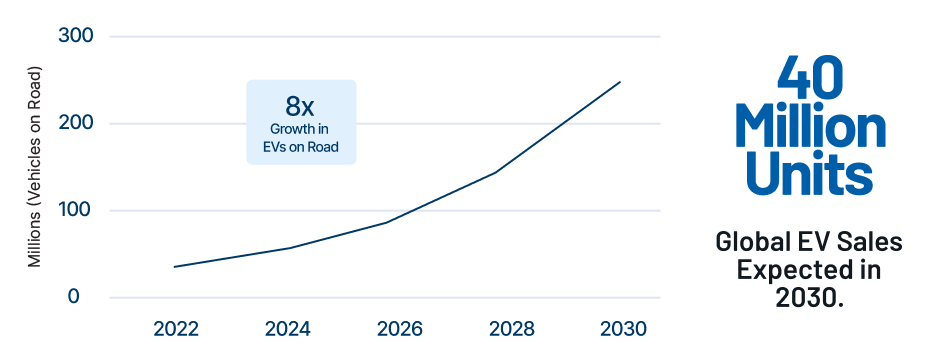
“2023年全球电动汽车展望:力争实现气候目标”。国际能源署2
Nuvation Energy首席执行官Michael Worry表示:“电动汽车的BMS是针对电动汽车的使用环境而设计的。虽然这种BMS在电动汽车上表现良好,但专为固定式储能系统设计的BMS能够提供更优异的性能和更大的规模效益。我们的客户选择将Nuvation Energy的BMS用于固定式ESS中的电池梯次应用,这是因为专为ESS设计的器件能够在更大范围内实现更出色的性能。”
发展电池梯次利用市场是Nuvation和ADI共享生态系统战略的关键组成部分,对于经济和环境都有显著的促进作用。管理着大量废旧电池的组织可以将那些电池重新用于储存风力发电和太阳能发电产生的多余电能,这无疑是开辟了新的收入来源。电池成本约占电动汽车成本的30%,得益于电池的生命周期价值的提升,总拥有成本得以降低。延长电池寿命还能减轻原材料开采压力,并减少最终进入垃圾填埋场的电池数量。

合作发展ESS生态系统
如今,Nuvation Energy为汽车公司、系统集成商和电池仓储企业提供先进的能源管理解决方案和ESS设计服务,助其实现电动汽车电池的梯次利用,延长电池的生命周期。稳健的梯次利用战略能够为拥有大量退役电动汽车电池的组织开拓新的收入来源,降低高昂的仓储成本,并在电池仍有使用价值时,延迟对其进行回收处理。Nuvation的解决方案有助于尽可能减少能源浪费,支持分布式能源的发展,并推动构建开放的能源市场,以便商业微电网和能源生产商将富余的可再生能源出售给电网,从而在支持电网稳定的同时获得收益。
ADI可持续能源总经理Nitin Sharma表示:“我们将继续与Nuvation Energy密切合作,并将携手其他生态系统合作伙伴共创佳绩。”Nuvation Energy首席执行官Michael Worry表示:“我们将ADI公司视为重要的合作伙伴,未来我们将共同攻克下一代平台和系统面临各种棘手挑战,积极开拓储能市场,并为我们的客户提供出色的ESS解决方案。”
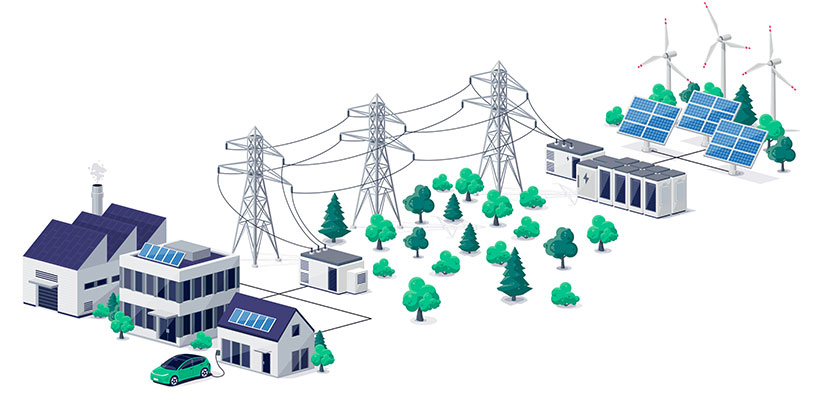
参考文献
1Battery Management Systems.。Nuvation Energy。
2“Global EV Outlook 2023: Catching Up with Climate Ambitions”。国际能源署。


